
Lake Champlain is a natural freshwater lake in North America. It mostly lies between the US states of New York and Vermont, but also extends north into the Canadian province of Quebec.
USS Enterprise was a Continental Army sloop-of-war that served in Lake Champlain during the American Revolutionary War. She was the first of a long and prestigious line of ships of the United States or by the combatant forces of the U.S. Revolutionary War to bear the name Enterprise.

The Battle of Plattsburgh, also known as the Battle of Lake Champlain, ended the final British invasion of the northern states of the United States during the War of 1812. Two British forces, an army under Lieutenant General Sir George Prévost and a naval squadron under Captain George Downie converged on the lakeside town of Plattsburgh, New York. Plattsburgh was defended by New York and Vermont militia and detachments of regular troops of the United States Army, all under the command of Brigadier General Alexander Macomb, and ships commanded by Master Commandant Thomas Macdonough.

The Invasion of Quebec was the first major military initiative by the newly formed Continental Army during the American Revolutionary War. The objective of the campaign was to seize the Province of Quebec from Great Britain, and persuade French-speaking Canadiens to join the revolution on the side of the Thirteen Colonies. One expedition left Fort Ticonderoga under Richard Montgomery, besieged and captured Fort St. Johns, and very nearly captured British General Guy Carleton when taking Montreal. The other expedition, under Benedict Arnold, left Cambridge, Massachusetts, and traveled with great difficulty through the wilderness of Maine to Quebec City. The two forces joined there, but they were defeated at the Battle of Quebec in December 1775.
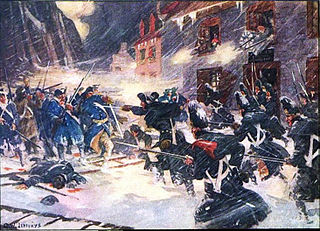
The Battle of Quebec was fought on December 31, 1775, between American Continental Army forces and the British defenders of Quebec City early in the American Revolutionary War. The battle was the first major defeat of the war for the Americans, and it came with heavy losses. General Richard Montgomery was killed, Benedict Arnold was wounded, and Daniel Morgan and more than 400 men were taken prisoner. The city's garrison, a motley assortment of regular troops and militia led by Quebec's provincial governor, General Guy Carleton, suffered a small number of casualties.

This section of the timeline of Quebec history concerns the events between the fall of Quebec as part of New France during the French and Indian Wars and as part of British North America, through the adoption of the Quebec Act (1774), until just before the division of the province into Upper and Lower Canada by the Constitutional Act (1791).

Seth Warner was an American soldier. He was a Revolutionary War officer from Vermont who rose to rank of Continental colonel and was often given the duties of a brigade commander. He is best known for his leadership in the capture of Fort Crown Point, the Battle of Longueuil, the siege of Quebec, the retreat from Canada, and the battles of Hubbardton and Bennington.

The King's Royal Regiment of New York, also known as Johnson's Royal Regiment of New York, King's Royal Regiment, King's Royal Yorkers, and Royal Greens, were one of the first Loyalist regiments, raised on June 19, 1776, in British Canada, during the American Revolutionary War.

The Battle of Longue-Pointe was an attempt by Ethan Allen and a small force of American and Quebec militia to capture Montreal from British forces on September 25, 1775, early in the American Revolutionary War. Allen, who had been instructed only to raise militia forces among the local inhabitants, had long had thoughts of taking the lightly defended city. When he reached the southern shore of the St. Lawrence River with about 110 men, he seized the opportunity to try. Major John Brown, whom Allen claimed was supposed to provide additional forces, did not appear as they had planned, isolating Allen and his men on the north side of the river.
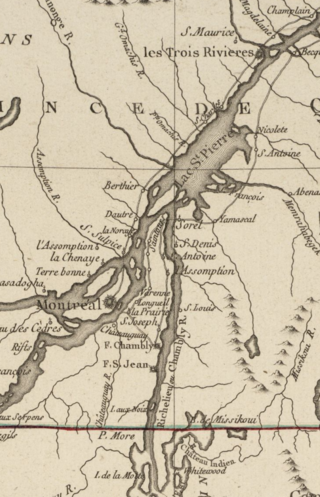
The siege of Fort St. Jean was conducted by American Brigadier General Richard Montgomery on the town and fort of Saint-Jean in the British province of Quebec during the American Revolutionary War. The siege lasted from September 17 to November 3, 1775.

USS Saratoga was a corvette built in Vergennes, Vermont, for service on Lake Champlain in the War of 1812. She was named for the Battles of Saratoga.
The Royalton raid was a British-led Indian raid in 1780 against various towns along the White River Valley in the Vermont Republic, and was part of the American Revolutionary War. It was the last major Indian raid in New England.
Lieutenant Colonel John Enys was a British Army officer who served during the American Revolution.
Lt.-Colonel Christopher Carleton (1749–1787) was born into an Ulster military family in Newcastle-upon-Tyne, England. Christopher's parents died at sea when he was only four years old and his uncles, Guy Carleton, the future Governor General of Canada and Commander-in-Chief, North America, along with Thomas Carleton, later the 1st Governor of New Brunswick, saw to his education and upbringing. At the age of twelve, Chistopher joined the British Army as an ensign in the 31st Regiment of Foot. Before his first tour of duty in North America, Chistopher married Anne Howard, whose sister Maria was the wife of Guy Carleton. While in North America, Christopher Carleton met Sir William Johnson and lived among the Mohawk Indians, learning their language and partaking in their customs. He would remark in later life that the time spent living with the Mohawks was the happiest of his life. These skills would serve him well later. Christopher would be back in England when the American Revolutionary War broke out in 1775.
General Thomas Carleton was an Irish-born British Army officer who was promoted to colonel during the American Revolutionary War after relieving the siege of Quebec in 1776. After the war, he was appointed as Lieutenant-Governor of New Brunswick, and supervised the resettlement of Loyalists from the United States in the province. He held this position until his death, although he was absent in England for the last fourteen years of his tenure, refusing orders to return in a dispute about seniority.

Île aux Noix is an island on the Richelieu River in Quebec, close to Lake Champlain. The island is the site of Fort Lennox National Historic Site of Canada. Politically, it is part of Saint-Paul-de-l'Île-aux-Noix.

The northern theater of the American Revolutionary War after Saratoga consisted of a series of battles between American revolutionaries and British forces, from 1778 to 1782 during the American Revolutionary War. It is characterized by two primary areas of activity. The first set of activities was based around the British base of operations in New York City, where each side made probes and counterprobes against the other's positions that sometimes resulted in notable actions. The second was essentially a frontier war in Upstate New York and rural northern Pennsylvania that was largely fought by state militia companies and some Indian allies on the American side, and Loyalist companies supported by Indians, British Indian agents, and occasionally British regulars. The notable exception to significant Continental Army participation on the frontier was the 1779 Sullivan Expedition, in which General John Sullivan led an army expedition that drove the Iroquois out of New York. The warfare amongst the splinters of the Iroquois Six Nations were particularly brutal, turning much of the Indian population into refugees.
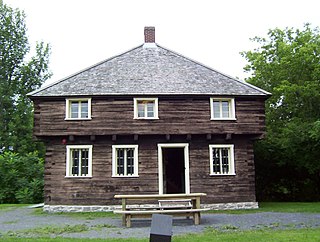
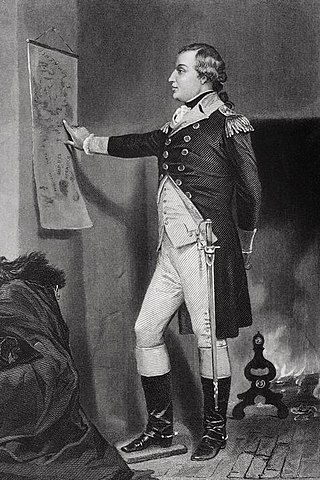
Richard Montgomery was an Ulster-Scots soldier who first served in the British Army. He later became a major general in the Continental Army during the American Revolutionary War, and he is most famous for leading the unsuccessful 1775 invasion of northeastern Quebec.
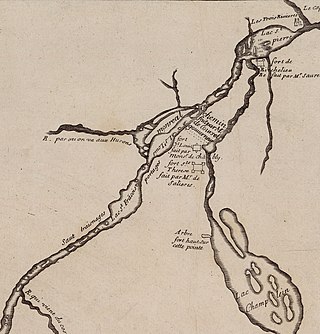
The Sainte-Thérèse Raid was a military raid on the town of Sainte-Thérèse in French Canada conducted by British elite forces known as Rogers' Rangers that took place during the French and Indian War from 3 to 18 June 1760. Led by Robert Rogers the raid was a pre-emptive strike ordered by Major General Jeffery Amherst as a prelude to his three pronged attack on Montreal the following month.














